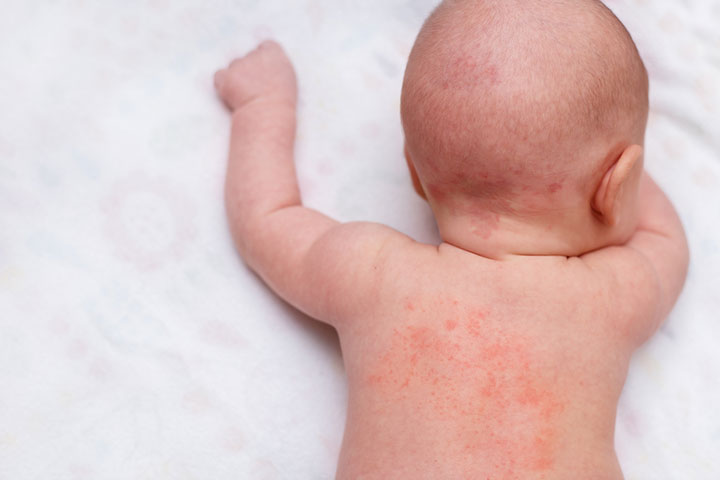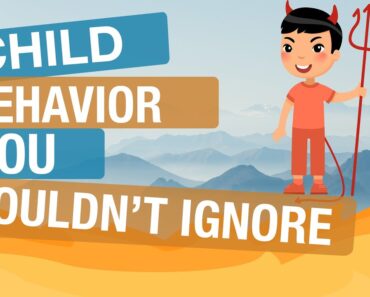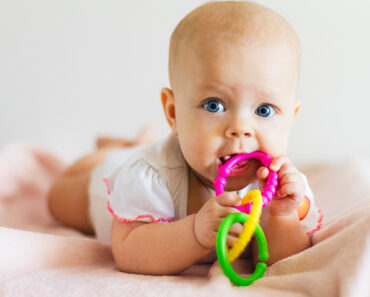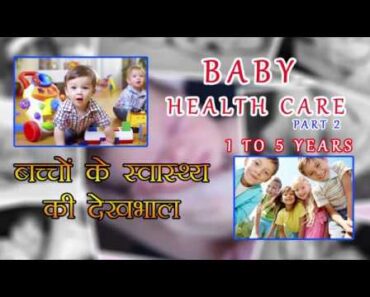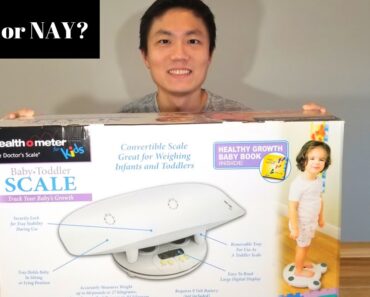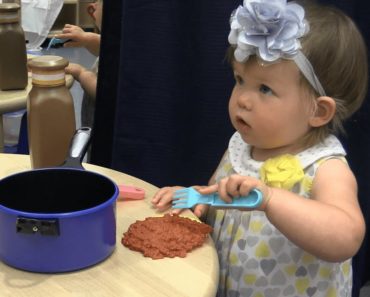Anaphylaxis is a rapid and severe allergic reaction where cells release the compound histamine in large quantities in response to an allergen. It leads to several physiological changes in the body, such as swelling in various body parts due to leakage of fluids, increased heart rate, and trouble breathing(1).
An anaphylactic reaction may happen in seconds or may take as long as an hour after the exposure to the allergen (2). The condition could occur in infants and toddlers, too (3). Anaphylaxis needs immediate medical care as it can be life-threatening.
This post will give you the necessary information about the signs, symptoms, causes, and management of anaphylaxis in infants.
Signs Of Anaphylaxis
The signs may appear in seconds, minutes, or hours after exposure to the allergen. In most cases, they appear quickly. The signs and symptoms could vary in each baby based on their sensitivity to the allergen and the quantity of allergen.
Below are some of the common signs of anaphylaxis in babies(2)(3).
- Sneezing or stuffy and runny nose
- Swelling of lips and tongue
- Tightness or swelling of the throat, tongue, or uvula
- Hoarseness of voice, noticeable while crying
- Wheezing sound while breathing
- Hives or rashes on the body
- Reddish or bluish skin color
Risk Factors For Anaphylaxis In Babies
Anaphylaxis may occur without any predisposition or presence of risk factors. However, if your baby has one or more of the following conditions, they may have a higher risk of experiencing anaphylaxis (2).
- A family history of anaphylaxis
- A previous history of anaphylaxis
Causes Of Anaphylaxis In Babies
An anaphylactic reaction happens as a response to allergen contact. Each baby may be sensitive to a different allergen. The following are the commonly identified allergens(4)(5).
1. Foods
Babies older than six months are usually at a higher risk of anaphylaxis due to food items. Infants younger than six months may have a risk if they consume infant food or formula made with potential allergens, such as soy and milk. Below are food items that are commonly associated with allergy and anaphylaxis.
- Legumes, such as peanuts, beans, lentils, and peas
Any fruit and vegetable could also be a potential allergen, and it could depend on the sensitivity of the baby towards a specific fruit or vegetable.
2. Insect stings
The venom and saliva of the following insects could trigger anaphylaxis due to a sting or bite.
3. Medicines
The reaction to the following medicines may depend on various factors, including the dosage and whether it cross-reacts with other potential allergens.
- Certain antibiotics, such as penicillin
- Non-steroidal anti-inflammatory drugs (NSAIDs), such as ibuprofen and anesthesia
4. Miscellaneous
Anaphylaxis may also occur due to compounds found in everyday items, such as toys, and substances found in nature, such as pollen. Below are some of the common potential allergens.
- Dyes in clothes, toys, and food
Diagnosis Of Anaphylaxis In Babies
A pediatrician will diagnose anaphylaxis based on the symptoms and allergen-contact history, such as if the baby came in contact or consumed a potential allergen within hours of developing symptoms. The doctor may also ask for medical history to corroborate their findings.
The healthcare provider will note the following to confirm a diagnosis of anaphylaxis (2).
- Any episode of allergic reaction to a known or possible allergen
- Blood tests may be conducted in rare cases
How To Respond To An Anaphylactic Reaction?
The anaphylactic reaction should be immediately dealt with as it might be fatal. The following steps must be followed if you notice an anaphylactic reaction in your baby(6).
- Epinephrine is the first line of treatment as it quickly reverses the life-threatening symptoms of anaphylaxis. The doctor may prescribe epinephrine auto-injectors for your baby if your baby is at a high risk of developing anaphylaxis or has a previous history.
- Epinephrine is available in auto-injectable syringes. The muscle in the outer part of the thigh is usually the best place to inject it.
- A second dose may be needed if the symptoms do not subside in one dose. Carry two doses of epinephrine every time.
- After administering epinephrine, note the exact time of administration and call the local emergency number.
- Call an ambulance with epinephrine shots in case you do not have epinephrine injections handy.
- Lay the baby on their back. If the baby vomits or has trouble breathing, turn the baby to their side.
- You may administer other medications such as a bronchodilator and antihistamine prescribed by the doctor. However, do not use these medications as a substitute for epinephrine.
Treatment For Anaphylaxis In Babies
The best treatment of anaphylaxis is to subdue the symptoms before they turn into complications or cause severe discomfort to the baby. This approach is best explained by the mnemonic REACT (7).
1. R: Recognizing the symptoms of anaphylaxis
Stay alert and remember the usual signs of anaphylaxis in babies. If your baby is at a higher risk of anaphylaxis, educate other people at home and at the baby’s daycare about the steps to identify the symptoms and handle the situation.
2. E: Epinephrine administration
Epinephrine comes in auto-injectable syringes. EpiPen or AuviQ are some of the common trade names for epinephrine auto-injectors. It is available on prescription only. The outer part of the thigh muscle is usually the best place to administer epinephrine.
3. ACT: Activate the emergency response
Keep the following steps in mind.
- If your baby’s pediatrician has given you an allergy action plan, follow the steps included in that plan.
- After you administer the epinephrine, call the local emergency number immediately.
- Lay the baby on their back or side until the ambulance arrives.
- Take the baby to a hospital as soon as the ambulance arrives.
Do note it is best to administer epinephrine to the baby if you are unsure if it is an anaphylactic shock. If the baby is taken to the hospital emergency, they may receive supportive treatment, such as additional epinephrine, IV fluids, and oxygen support.
Prevention Of Anaphylaxis In Babies
The best way to prevent anaphylaxis in babies is to keep the baby away from any known or potential allergens. Inform the baby’s daycare and caregivers about any known food allergies. Exposure to insect bites and pollen can be avoided by dressing the baby in protective clothing, using insect mesh on windows, and avoiding parks or places where there could be pollen and insects. If the baby is allergic to dye, latex, or any other compounds, get rid of the item and do not use it again (2).
Anaphylaxis reactions can be unpredictable, and it is essential to memorize the signs to react early. Do not delay asking for medical help if your baby shows any symptoms of anaphylaxis. Speak to your baby’s healthcare provider to learn the management and prevention of anaphylaxis in your baby.
